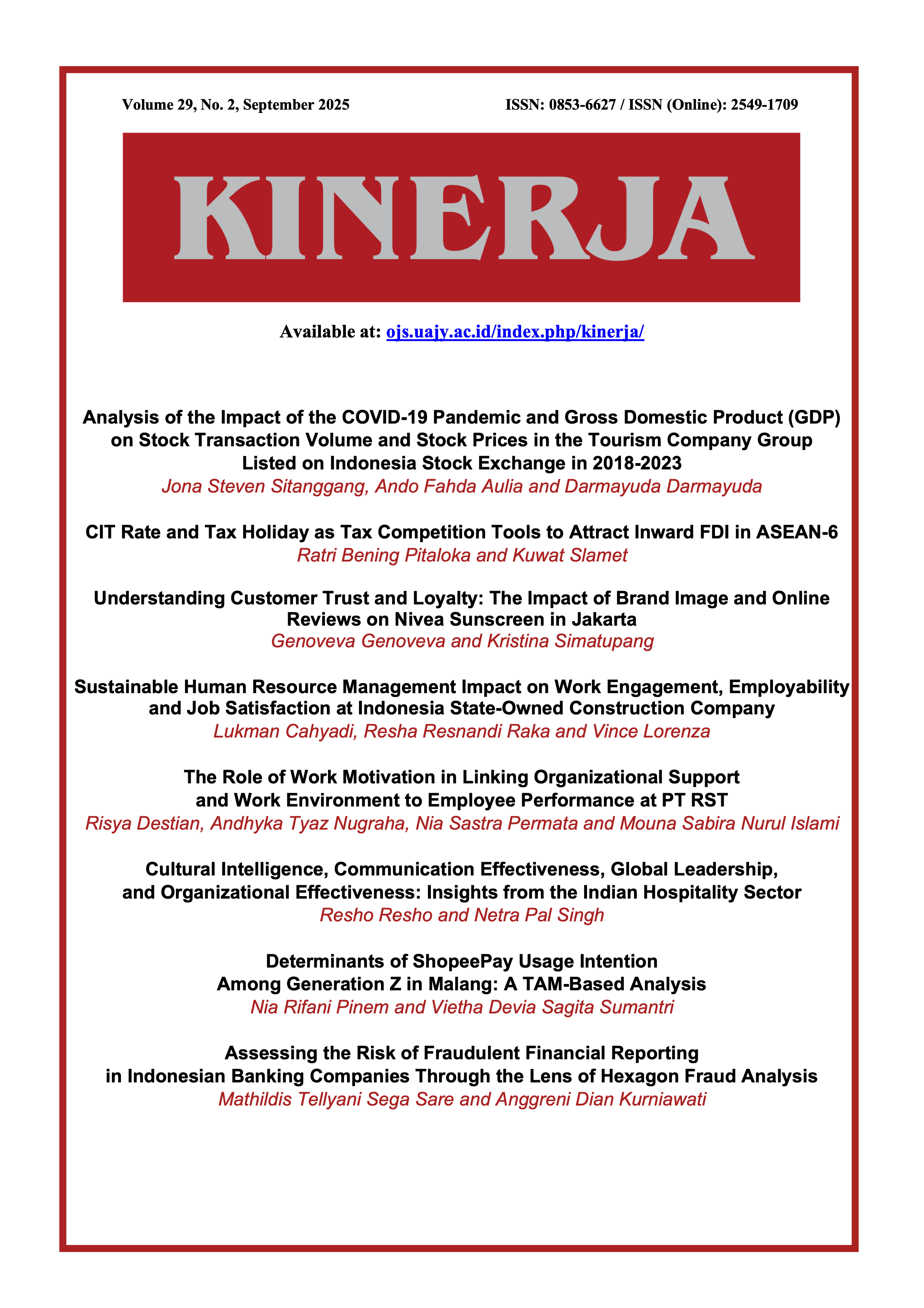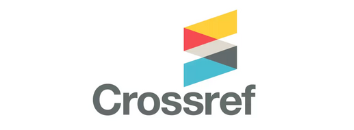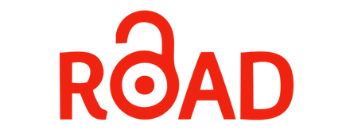Assessing the Risk of Fraudulent Financial Reporting in Indonesian Banking Companies Through the Lens of Hexagon Fraud Analysis
DOI:
https://doi.org/10.24002/kinerja.v29i2.12289Keywords:
banking, eckel index, fraud hexagon, fraudulent financial reporting, income smoothingAbstract
The study aims to determine the impact of hexagon fraud on the detection of potential fraudulent financial statements. The study identified several factors that may have contributed to the emergence of potentially fraudulent financial reporting. These factors included the financial stability of the pressure element, the ineffective monitoring of the opportunity element, the change of auditor of the rationalization element, changes in the director of the capability element, the CEO duality of the ego element, and the political connection of the collusion element. The Eckel Index projects the possibility of fraudulent financial statements. The sample in this study is a banking company listed on the Indonesian Stock Exchange in the period 2018 to 2022. Sample obtained by purposive sampling. This study will highlight the possibility of fraudulent financial reporting, particularly regarding income smoothing practices used by Indonesian banks. The insights obtained from the hexagon fraud analysis can be leveraged by a banking institution to enhance its sustainable management procedures in the future.
References
ACFE, 2022. Occupational Fraud 2022: A Report To The Nations. Association of Certified Fraud Examiners, pp. 1–96.
ACFE Indonesia, 2019. Survei Fraud Indonesia 2019.
Achmad, T., Ghozali, I. & Pamungkas, I.D., 2022. Hexagon fraud: Detection of fraudulent financial reporting in state-owned enterprises Indonesia. Economies, 10(1), pp.1–16. Available at: https://doi.org/10.3390/economies10010013
AICPA, 2003. Fraud Detection in a GAAS Audit: SAS No. 99 Implementation Guide. Available at: https://egrove.olemiss.edu/aicpa_guides.
Al-Rizky, N., Indrijawati, A. & Juwita Purisamya, A., 2024. Analisis financial statement fraud dengan pendekatan Vousinas hexagon fraud theory. Akrual: Jurnal Bisnis dan Akuntansi Kontemporer, (January), pp. 62–81. Available at: https://doi.org/10.26487/akrual.v17i01.30778
Correia, M.M., 2014. Political connections and SEC enforcement. Journal of Accounting and Economics, 57(2–3), pp. 241–262. Available at: https://doi.org/10.1016/j.jacceco.2014.04.004.
Dalton, D.R. et al., 1999. Number of directors and financial performance: A meta-analysis. The Academy of Management Journal, 42(6), pp. 674–686. Available at: https://www.jstor.org/stable/256988.
Dorminey, J. et al., 2012. The evolution of fraud theory. Issues in Accounting Education, 27(2), pp. 555–579. Available at: https://doi.org/10.2308/iace-50131.
Fadhilah, N.H. et al., 2021. Analisis kecurangan laporan keuangan dalam perspektif fraud pentagon. Jurnal Aktiva : Riset Akuntansi Dan Keuangan, 5(2), pp. 92–109.
Handoko, B.L. & Tendean, D., 2021. An analysis of fraud hexagon in detecting financial statement fraud (empirical study of listed banking companies on Indonesia stock exchange for period 2017–2019). In: ICEBA 2021: 7th International Conference on E-Business and Applications. pp.93–100.
Hidayah, E. & Devi Saptarini, G., 2020. Pentagon fraud analysis in detecting potential financial statement fraud of banking companies in Indonesia. UII-ICABE 2019, 1(1), pp. 89–102.
Horwarth, C., 2012. Why the Fraud Triangle is no Longer Enough. Horwath: Crowe LLP.
Jannah, R. & Praptoyo, S., 2023. Fraud hexagon theory dalam mendeteksi kecurangan laporan keuangan. Jurnal Ilmu dan Riset Akuntansi, 12(9), pp. 1–22.
Jannah, V.M., Andreas & Rasuli, M., 2021. Pendekatan Vousinas fraud hexagon model dalam mendeteksi kecurangan pelaporan keuangan. Studi Akuntansi dan Keuangan Indonesia, 4(1), pp. 1–16. Available at: https://doi.org/10.21632/saki.4.1.1-16.
Jensen, M.C. & Meckling, W.H., 1976. Theory of the firm: Managerial behavior, agency costs and ownership structure. Journal of Financial Economics, (4), pp. 305–360. Available at: http://ssrn.com/abstract=94043Electroniccopyavailableat:http://ssrn.com/abstract=94043http://hupress.harvard.edu/catalog/JENTHF.html.
Juniarty, D.A. & Kurniawati, A.D., 2025. Fraud diamond sebagai indikator deceptive income smoothing di perusahaan perbankan publik Indonesia. Modus, 37(1), pp. 81–100. Available at: https://doi.org/10.24002/modus.v37i1.10252.
Khoir, A. & Kusumawati, E., 2020. Analisis fraud triangle untuk mendeteksi financial statement fraud. IJAB : Indonesian Journal of Accounting and Business, 2(1), pp. 72–94. Available at: https://doi.org/10.33019/accounting.v2i1.20.
Kurniawati, A.D., 2021a. Analisa fraud diamond dalam pendeteksian tindakan financial shenanigans. Modus, 33(2), pp. 174–195. Available at: https://doi.org/10.24002/modus.v33i2.4658.
Kurniawati, A.D., 2021b. Red flags to detect fraudulent financial reporting in Indonesian banking sector. Proceedings of the 2nd International Conference on Business and Management of Technology (ICONBMT 2020), 175(Icbmt 2020), pp. 315–321. Available at: https://doi.org/10.2991/aebmr.k.210510.049.
Lou, Y.I. & Wang, M.L., 2009. Fraud risk factor of the fraud triangle assessing the likelihood of fraudulent financial reporting. Journal of Business & Economics Research (JBER), 7(2), pp. 61–78. Available at: https://doi.org/10.19030/jber.v7i2.2262.
Masako, N.D. & Stoughton, M.N., 1986. Moral hazard and adverse selection: The question of financial structure. The Journal of Finance, 41(2), pp. 501–513.
Octani, J., Dwiharyadi, A. & Djefris, D., 2022. Analisis pengaruh fraud hexagon terhadap fraudulent financial reporting pada perusahaan sektor keuangan yang terdaftar di Bursa Efek Indonesia selama tahun 2017–2020. Jurnal Akuntansi, Bisnis dan Ekonomi Indonesia (JABEI), 1(1), pp. 36–49. Available at: https://doi.org/10.30630/jabei.v1i1.9.
Osazuwa, N. P., 2016. Political connection, board characteristics and firm performance in Nigeria. International Soft Science Conference, pp. 769–774. Available at: https://doi.org/10.15405/epsbs.2016.08.108.
Pamungkas, I.D. & Utomo, S.D., 2018. Fraudulent financial reporting: An application of fraud pentagon theory to association of Southeast Asian nations corporate governance scorecard. Journal of Advanced Research in Law and Economics, 9(5), pp. 1729–1737. Available at: https://doi.org/10.14505/jarle.v9.5(35).26.
Putri & Deviesa, D., 2017. Pengaruh CEO duality terhadap financial performance dengan earnings management sebagai variabel intervening. Business Accounting Review, 5(1), pp. 169–180. Available at: http://download.garuda.kemdikbud.go.id/article.php?article=1243349&val=6513&title=Pengaruh CEO Duality Terhadap Financial Performance Dengan Earnings Management Sebagai Variabel Intervening.
Raz, A.F., Indra, T.P. & Artikasih, D.K., 2013. Krisis keuangan global dan pertumbuhan ekonomi. Bulletin of Monetary Economics and Banking, 15 (2)(2), pp. 37–56. Available at: https://doi.org/10.21098/bemp.v15i2.61.
Sari, M.P. et al., 2022. The audit committee as moderating the effect of hexagon’s fraud on fraudulent financial statements in mining companies listed on the Indonesia stock exchange. Cogent Business and Management, 9(1). Available at: https://doi.org/10.1080/23311975.2022.2150118.
Sarikhani, M. & Ebrahimi, F., 2022. Whistleblowing by accountants: An integration of the fraud pentagon and the extended theory of planned behavior. Meditari Accountancy Research, 30(6), pp. 1740–1763. Available at: https://doi.org/10.1108/MEDAR-10-2020-1047.
Scott, W., 2015. Financial Accounting Theory. 7th Editio. Ontario: Pearson Canada Inc.
Shelton, A. M., 2014. Analysis of Capabilities Attributed to the Fraud Diamond Analysis of Capabilities Attributed to the Fraud Diamond. Available at: https://dc.etsu.edu/honors/213.
Skousen, C.J. & Twedt, B.J., 2009. Fraud score analysis in emerging markets. Cross Cultural Management: An International Journal, 16(3), pp. 301–316. Available at: https://doi.org/10.1108/13527600910977373.
Thamlim, W. & Reskino, 2023. Fraudulent financial reporting with fraud pentagon perspective: The role of corporate governance as moderator. American Journal of Humanities and Social Science Resesarch (AJHSSR), 07(01), pp. 18–38.
Tugas, F.C., 2012. Exploring a new element of fraud: A study on selected financial accounting fraud cases in the world. American International Journal of Contemporary Research, 2(6), pp. 112–121. Available at: https://d1wqtxts1xzle7.cloudfront.net/37821194.
Ufiana, B. & Triyanto, D.N., 2022. Pengaruh fraud diamond terhadap kecurangan laporan keuangan perusahaan sektor industri barang konsumsi yang terdaftar di Bursa Efek Indonesia tahun 2016–2020. EKOMBIS REVIEW: Jurnal Ilmiah Ekonomi dan Bisnis, 10(2), pp. 859–868. Available at: https://doi.org/10.37676/ekombis.v10i2.2680.
Utami, E.R. & Pusparini, N.O., 2019. The analysis of fraud pentagon theory and financial distress for detecting fraudulent financial reporting in banking sector in Indonesia. Proceedings of ICAF, pp.60–65. Available at: https://doi.org/10.2991/icaf-19.2019.10.
Vousinas, G.L., 2019. Advancing theory of fraud: The S.C.O.R.E. model. Journal of Financial Crime, 26(1), pp. 372–381. doi: https://doi.org/10.1108/JFC-12-2017-0128.
Widyatama, W. & Setiawati, L.W., 2021. Analisis pengaruh fraud pentagon theory terhadap fraudulent financial reporting pada perusahaan perbankan yang terdaftar di Bursa Efek Indonesia periode 2014–2019. BALANCE: Jurnal Akuntansi, Auditing dan Keuangan, 17(1), pp. 22–47. Available at: https://doi.org/10.25170/balance.v17i1.2010.
Wolfe, D.T. & Hermanson, D.R., 2004. The fraud diamond: Considering the four elements of fraud. The CPA Journal, 74(12), pp. 38–42.
Downloads
Published
Issue
Section
License
Copyright (c) 2025 Mathildis Tellyani Sega Sare, Anggreni Dian Kurniawati

This work is licensed under a Creative Commons Attribution 4.0 International License.















